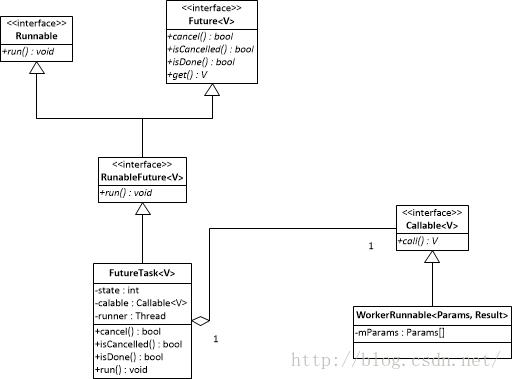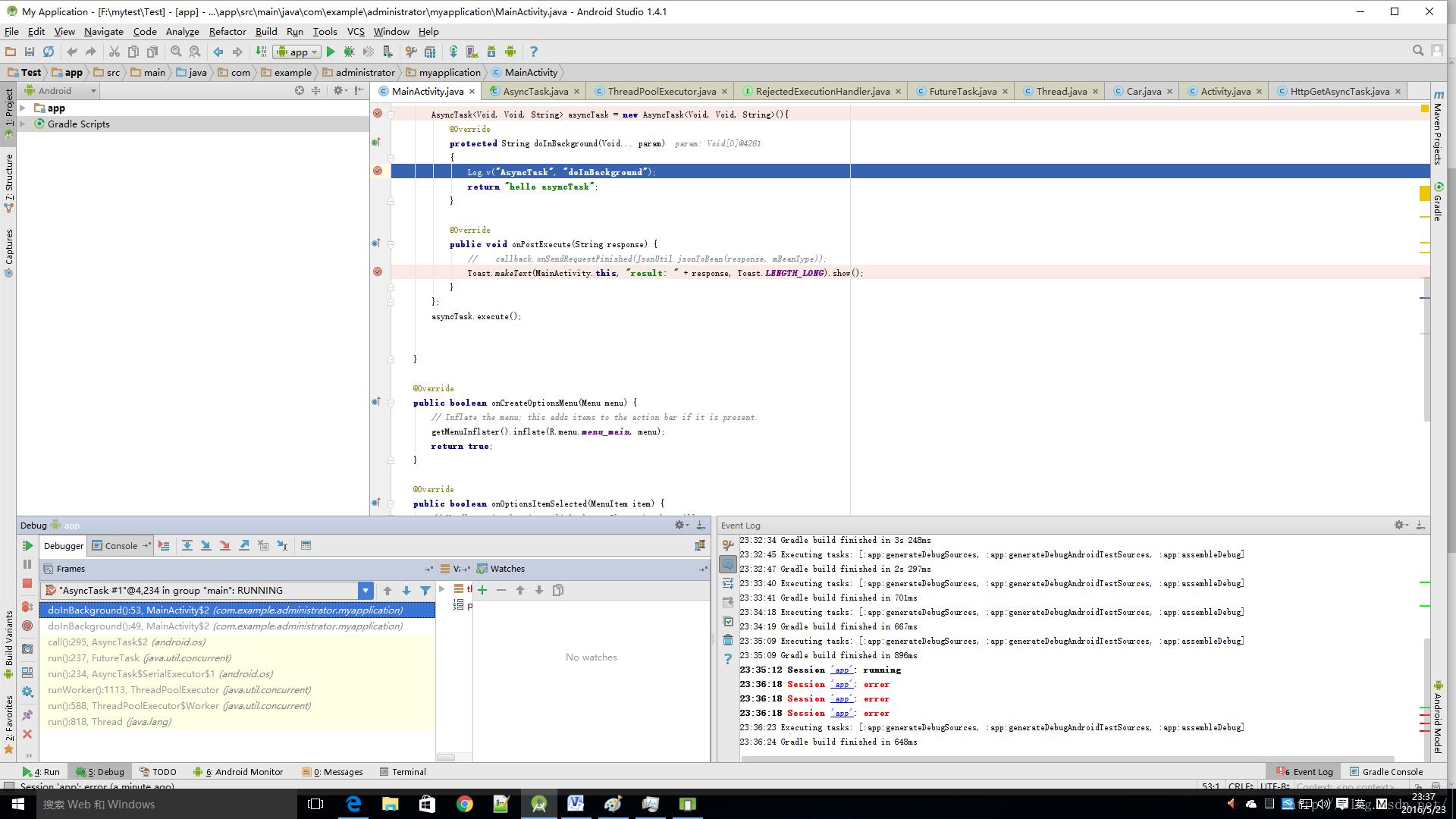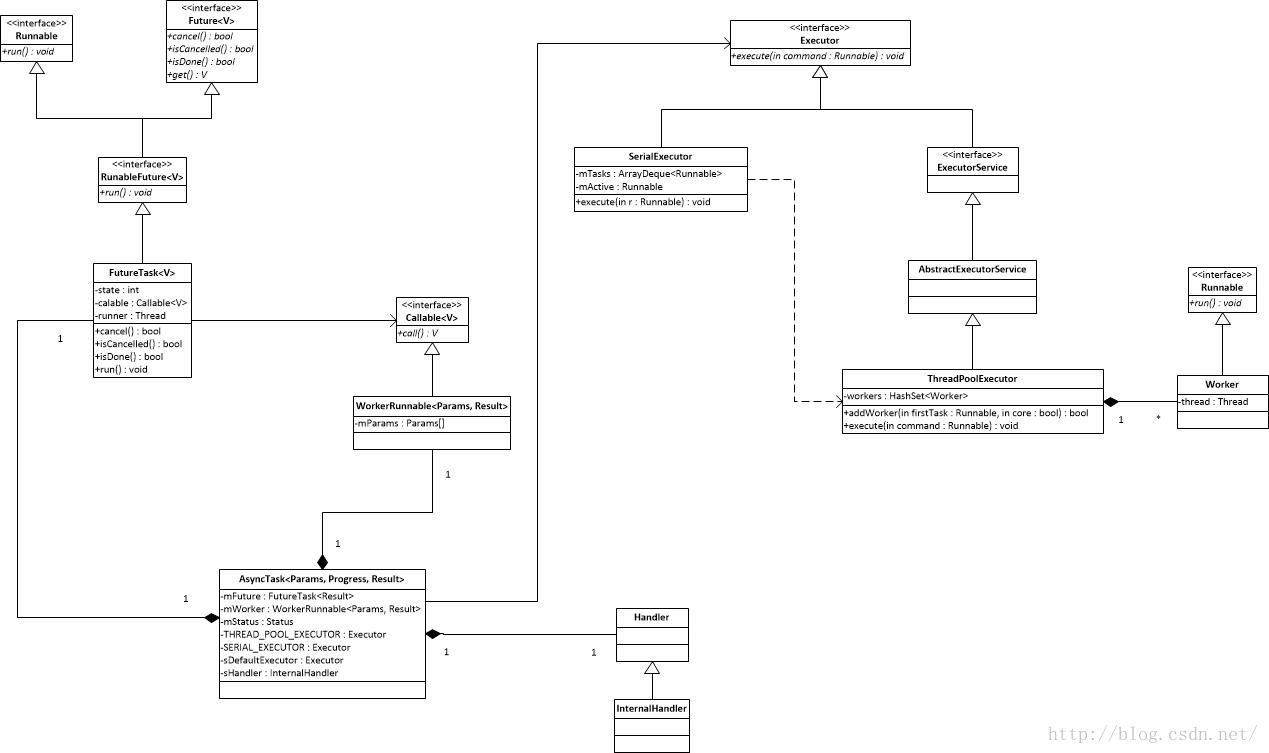AsyncTask - 基本原理 图文剖析
Posted zj510
tags:
篇首语:本文由小常识网(cha138.com)小编为大家整理,主要介绍了AsyncTask - 基本原理 图文剖析相关的知识,希望对你有一定的参考价值。
最近用到了AsyncTask,这玩意每个写android程序的都会用,可是不见得每个人都能用的好。如果想要用好,那么首先势必对基本原理有个大概了解。其实网上对这类问题的说明已经很多很多了,这里我就用自己的思维整理一下。
AsyncTask概述
AsyncTask是google公司封装的一个轻量级的异步任务类。实际上它内部也是通过Thread + handler实现的。如果没有AsyncTask类,我们完全可以用thread+handler来处理。这个时候就很可能自己回去封装一下thread+handler了。正是因为这类需求很多,google就帮我们封装了一下。其实我们也可以自己封装,但是我相信99%程序员自己封装的东西比不上google的。所以还是有必要学习一下AsyncTask。
AsyncTask相关的其他类
首先我们看一下AsyncTask用到了哪些主要的框架?注意,每个版本的sdk可能对AsyncTask的实现有所不同,我这里用的是Android-23.
下面是从sdk里面copy出来的AsyncTask一部分内容。
public abstract class AsyncTask<Params, Progress, Result>
private static final String LOG_TAG = "AsyncTask";
private static final int CPU_COUNT = Runtime.getRuntime().availableProcessors();
private static final int CORE_POOL_SIZE = CPU_COUNT + 1;
private static final int MAXIMUM_POOL_SIZE = CPU_COUNT * 2 + 1;
private static final int KEEP_ALIVE = 1;
private static final ThreadFactory sThreadFactory = new ThreadFactory()
private final AtomicInteger mCount = new AtomicInteger(1);
public Thread newThread(Runnable r)
return new Thread(r, "AsyncTask #" + mCount.getAndIncrement());
;
private static final BlockingQueue<Runnable> sPoolWorkQueue =
new LinkedBlockingQueue<Runnable>(128);
/**
* An @link Executor that can be used to execute tasks in parallel.
*/
public static final Executor THREAD_POOL_EXECUTOR
= new ThreadPoolExecutor(CORE_POOL_SIZE, MAXIMUM_POOL_SIZE, KEEP_ALIVE,
TimeUnit.SECONDS, sPoolWorkQueue, sThreadFactory);
/**
* An @link Executor that executes tasks one at a time in serial
* order. This serialization is global to a particular process.
*/
public static final Executor SERIAL_EXECUTOR = new SerialExecutor();
private static final int MESSAGE_POST_RESULT = 0x1;
private static final int MESSAGE_POST_PROGRESS = 0x2;
private static volatile Executor sDefaultExecutor = SERIAL_EXECUTOR;
private static InternalHandler sHandler;
private final WorkerRunnable<Params, Result> mWorker;
private final FutureTask<Result> mFuture;
private volatile Status mStatus = Status.PENDING;
...
;
AsyncTask的数据成员主要有:
1. static Executor THREAD_POOL_EXECUTOR
2. static Executor SERIAL_EXECUTOR;
3. static Executor sDefaultExecutor; 这玩意默认指向了SERIAL_EXECUTOR。看源代码就知道了:
private static volatile Executor sDefaultExecutor = SERIAL_EXECUTOR;
4. static InternalHandler sHandler;
5. WorkerRunnable<Params, Result> mWorker;
6. FutureTask<Result> mFuture;
7. Status mStatus;
这7个是AsyncTask主要的数据成员,大部分功能都跟这些成员有关。主要上述7个数据成员中,前面4个都是静态的。
THREAD_POOL_EXECUTOR & SERIAL_EXECUTOR
这两个静态实例的类分别是:ThreadPoolExecutor和SerialExecutor.
类结构看起来像:

其中SerialExecutor很简单,全部代码也就:
private static class SerialExecutor implements Executor
final ArrayDeque<Runnable> mTasks = new ArrayDeque<Runnable>();
Runnable mActive;
public synchronized void execute(final Runnable r)
mTasks.offer(new Runnable()
public void run()
try
r.run();
finally
scheduleNext();
);
if (mActive == null)
scheduleNext();
protected synchronized void scheduleNext()
if ((mActive = mTasks.poll()) != null)
THREAD_POOL_EXECUTOR.execute(mActive);
SerialExecutor是AsyncTask的一个内嵌类。超简单,里面就2个数据成员:mTasks和mActive。每次caller调用那个execute,就创建一个Runnable匿名内嵌类对象,这个对象存入mTasks,在匿名内嵌类的run函数里面调用传入参数r.run()。然后通过一个scheduleNext函数把mTasks里面的所有对象通过THREAD_POOL_EXECUTOR.execute(mActive)执行一遍。说穿了,也就是说SerialExecutor类会把所有的任务丢入一个容器,之后把容器里面的所有对象一个一个的排队执行THREAD_POOL_EXECUTOR.execute(mActive);
ThreadPoolExecutor就相对复杂一点了。它有几个比较重要的数据成员:核心线程数,最大线程数,缓存队列。以下上AsyncTask的一部分代码。
private static final int CPU_COUNT = Runtime.getRuntime().availableProcessors();
private static final int CORE_POOL_SIZE = CPU_COUNT + 1;
private static final int MAXIMUM_POOL_SIZE = CPU_COUNT * 2 + 1;
private static final int KEEP_ALIVE = 1;
private static final ThreadFactory sThreadFactory = new ThreadFactory()
private final AtomicInteger mCount = new AtomicInteger(1);
public Thread newThread(Runnable r)
return new Thread(r, "AsyncTask #" + mCount.getAndIncrement());
;
private static final BlockingQueue<runnable> sPoolWorkQueue =
new LinkedBlockingQueue<runnable>(128);
public static final Executor THREAD_POOL_EXECUTOR
= new ThreadPoolExecutor(CORE_POOL_SIZE, MAXIMUM_POOL_SIZE, KEEP_ALIVE,
TimeUnit.SECONDS, sPoolWorkQueue, sThreadFactory);</runnable></runnable>当创建ThreadPoolExecutor对象的时候,构造函数里面第一个参数就是核心线程数量,这里取得是CPU个数 + 1, 第二个参数是最大线程数量,这里是CPU个数 * 2 + 1,第五个参数是缓冲区的队列,这里是个LinkedBlockingQueue,这个队列的最大容量是128.
实际上ThreadPoolExecutor内部有个线程池概念。它的大概工作原理如下:
1. 如果正在运行的线程数量小于核心线程数量(由调用者设置,像AsyncTask就设置了cpu个数+1),那么就新创建要给线程,来执行任务(execute的传入参数)
2. 如果正在运行的线程数量大于等于核心线程数量,这个时候就分两种情况:
a. 可以把任务丢进缓冲区,那就丢进去,等待空闲线程来执行。
b. 如果缓冲区满了,那就看最大线程数 - 运行线程数是不是>0。如果 > 0, 就创建线程来运行新的任务。如果=0,那就丢出异常,也就是ThreadPoolExecutor不接受这个任务了。(所以使用ThreadPoolExecutor的时候需要注意异常,因为它有可能不接受任务)以下是ThreadPoolExecutor的execute代码。
/**
* Executes the given task sometime in the future. The task
* may execute in a new thread or in an existing pooled thread.
*
* If the task cannot be submitted for execution, either because this
* executor has been shutdown or because its capacity has been reached,
* the task is handled by the current @code RejectedExecutionHandler.
*
* @param command the task to execute
* @throws RejectedExecutionException at discretion of
* @code RejectedExecutionHandler, if the task
* cannot be accepted for execution
* @throws NullPointerException if @code command is null
*/
public void execute(Runnable command)
if (command == null)
throw new NullPointerException();
/*
* Proceed in 3 steps:
*
* 1. If fewer than corePoolSize threads are running, try to
* start a new thread with the given command as its first
* task. The call to addWorker atomically checks runState and
* workerCount, and so prevents false alarms that would add
* threads when it shouldn't, by returning false.
*
* 2. If a task can be successfully queued, then we still need
* to double-check whether we should have added a thread
* (because existing ones died since last checking) or that
* the pool shut down since entry into this method. So we
* recheck state and if necessary roll back the enqueuing if
* stopped, or start a new thread if there are none.
*
* 3. If we cannot queue task, then we try to add a new
* thread. If it fails, we know we are shut down or saturated
* and so reject the task.
*/
int c = ctl.get();
if (workerCountOf(c) < corePoolSize)
if (addWorker(command, true))
return;
c = ctl.get();
if (isRunning(c) && workQueue.offer(command))
int recheck = ctl.get();
if (! isRunning(recheck) && remove(command))
reject(command);
else if (workerCountOf(recheck) == 0)
addWorker(null, false);
else if (!addWorker(command, false))
reject(command);
addWork也是蛮关键的一个函数,实现如下:大概就是可以的情况下,创建线程来执行任务。
private boolean addWorker(Runnable firstTask, boolean core)
retry:
for (;;)
int c = ctl.get();
int rs = runStateOf(c);
// Check if queue empty only if necessary.
if (rs >= SHUTDOWN &&
! (rs == SHUTDOWN &&
firstTask == null &&
! workQueue.isEmpty()))
return false;
for (;;)
int wc = workerCountOf(c);
if (wc >= CAPACITY ||
wc >= (core ? corePoolSize : maximumPoolSize))
return false;
if (compareAndIncrementWorkerCount(c))
break retry;
c = ctl.get(); // Re-read ctl
if (runStateOf(c) != rs)
continue retry;
// else CAS failed due to workerCount change; retry inner loop
boolean workerStarted = false;
boolean workerAdded = false;
Worker w = null;
try
w = new Worker(firstTask);
final Thread t = w.thread;
if (t != null)
final ReentrantLock mainLock = this.mainLock;
mainLock.lock();
try
// Recheck while holding lock.
// Back out on ThreadFactory failure or if
// shut down before lock acquired.
int rs = runStateOf(ctl.get());
if (rs < SHUTDOWN ||
(rs == SHUTDOWN && firstTask == null))
if (t.isAlive()) // precheck that t is startable
throw new IllegalThreadStateException();
workers.add(w);
int s = workers.size();
if (s > largestPoolSize)
largestPoolSize = s;
workerAdded = true;
finally
mainLock.unlock();
if (workerAdded)
t.start();
workerStarted = true;
finally
if (! workerStarted)
addWorkerFailed(w);
return workerStarted;
那么针对AsyncTask的情况,AsyncTask的任务是通过SerialExecutor来调用ThreadPoolExecutor的execute函数的,而SerialExecute已经通过要给容器控制任务一个一个执行了,所以这种情况下ThreadPoolExecutor只会有两种情况;
1. 没有任何线程在运行
2. 只有一个线程在运行,执行完一个任务就继续执行SerialExecutor的容器里面的下一个任务,如果有,就在当前线程里面继续执行,如果没有线程结束或者空闲。当serialExecutor有新任务来的时候,就再启动一个线程(或者用某个空闲线程)来执行任务。
总体来讲,针对AsyncTask,它有个静态数据成员SerialExecutor,
public static final Executor SERIAL_EXECUTOR = new SerialExecutor();也就是说所有的AsyncTask对象,不管有多少个,都共享同一个SerialExecutor对象(因为它是个静态成员)。
mWorker & mFuture
其实,这两个家伙只是对Runnable和callback的一个封装。结构图:

具体细节我们不见得要去关心。当AsyncTask构造函数调用的时候,mWorker和mFuture会被创建,同时mWoker会被传入到mFuture对象里面去
public AsyncTask()
mWorker = new WorkerRunnable<Params, Result>()
public Result call() throws Exception
mTaskInvoked.set(true);
Process.setThreadPriority(Process.THREAD_PRIORITY_BACKGROUND);
//noinspection unchecked
Result result = doInBackground(mParams);
Binder.flushPendingCommands();
return postResult(result);
;
mFuture = new FutureTask<Result>(mWorker)
@Override
protected void done()
try
postResultIfNotInvoked(get());
catch (InterruptedException e)
android.util.Log.w(LOG_TAG, e);
catch (ExecutionException e)
throw new RuntimeException("An error occurred while executing doInBackground()",
e.getCause());
catch (CancellationException e)
postResultIfNotInvoked(null);
;
这两个家伙的定义如下;
WorkerRunnable<Params, Result> mWorker;
FutureTask<Result> mFuture;
WorkerRunnable超简单:
private static abstract class WorkerRunnable<Params, Result> implements Callable<Result>
Params[] mParams;
就放了个数据成员:Params[] mParams。
那么整个流程大概是什么样子的呢?
1. 首先AsyncTask的构造函数会创建mWorker和mFuture。
2. 调用AsyncTask的execute过程如:
public final AsyncTask<Params, Progress, Result> execute(Params... params)
return executeOnExecutor(sDefaultExecutor, params);
public final AsyncTask<params result="" progress=""> executeOnExecutor(Executor exec,
Params... params)
if (mStatus != Status.PENDING)
switch (mStatus)
case RUNNING:
throw new IllegalStateException("Cannot execute task:"
+ " the task is already running.");
case FINISHED:
throw new IllegalStateException("Cannot execute task:"
+ " the task has already been executed "
+ "(a task can be executed only once)");
mStatus = Status.RUNNING;
onPreExecute();
mWorker.mParams = params;
exec.execute(mFuture);
return this;
</params>(private static volatile Executor sDefaultExecutor = SERIAL_EXECUTOR;)
有关WorkerRunnable和FutureTask的具体封装技巧,这里不做过多的描述,有兴趣可以自己去看,没兴趣就跳过。
调用例子
一个典型的调用如下:
AsyncTask<Void, Void, String> asyncTask = new AsyncTask<Void, Void, String>()
@Override
protected String doInBackground(Void... param)
Log.v("AsyncTask", "doInBackground");
return "hello asyncTask";
@Override
public void onPostExecute(String response)
// callback.onSendRequestFinished(JsonUtil.jsonToBean(response, mBeanType));
Toast.makeText(MainActivity.this, "result: " + response, Toast.LENGTH_LONG).show();
;
asyncTask.execute();
比如我们可以在onCreate里面调用这段代码。如果我们在doInBackground里面下断点,就会看到如下调用堆栈:

最终的doInBackground是在AsyncTask的构造函数里面创建的匿名内嵌类里面被调用的。
public AsyncTask()
mWorker = new WorkerRunnable<Params, Result>()
public Result call() throws Exception
mTaskInvoked.set(true);
Process.setThreadPriority(Process.THREAD_PRIORITY_BACKGROUND);
//noinspection unchecked
Result result = doInBackground(mParams);
Binder.flushPendingCommands();
return postResult(result);
;
mFuture = new FutureTask<Result>(mWorker)
@Override
protected void done()
try
postResultIfNotInvoked(get());
catch (InterruptedException e)
android.util.Log.w(LOG_TAG, e);
catch (ExecutionException e)
throw new RuntimeException("An error occurred while executing doInBackground()",
e.getCause());
catch (CancellationException e)
postResultIfNotInvoked(null);
;
mWorker是WorkerRunnable的子类(匿名内嵌子类)对象,mWorker被传给了mFuture,FutureTask的 callable就是mWorker。
public FutureTask(Callable<V> callable)
if (callable == null)
throw new NullPointerException();
this.callable = callable;
this.state = NEW; // ensure visibility of callable
mFuture被传到了AsyncTask的execute里面,mFuture实际上就是Runnable的一个子类,mFuture被被SerialExecute传给ThreadPoolExecute来执行。大概流程:
1. ThreadPoolExecutor里面的一个线程执行任务(mFuture)
2. FutureTask的run()会在线程里面被执行
3. Future的run()里面会尝试获得callable,然后调用callable的call()函数。callable就是mWorker,也就是WorkRunnable,而WorkRunnable实现了接口Callable,Callable里面有个方法就是call()。
public void run()
if (state != NEW ||
!U.compareAndSwapObject(this, RUNNER, null, Thread.currentThread()))
return;
try
Callable<V> c = callable;
if (c != null && state == NEW)
V result;
boolean ran;
try
result = c.call();
ran = true;
catch (Throwable ex)
result = null;
ran = false;
setException(ex);
if (ran)
set(result);
finally
// runner must be non-null until state is settled to
// prevent concurrent calls to run()
runner = null;
// state must be re-read after nulling runner to prevent
// leaked interrupts
int s = state;
if (s >= INTERRUPTING)
handlePossibleCancellationInterrupt(s);
4. 这样,mWorker是WorkerRunnable的子类对象,而且刚好实现了call函数,而call函数通过接口Callable在FutureTask的run()里面被调用了。所以AsyncTask的构造函数里面的匿名内嵌类里面的call实现被ThreadPoolExecutor的线程调用了。也就是这段代码:
mWorker = new WorkerRunnable<Params, Result>()
public Result call() throws Exception
mTaskInvoked.set(true);
Process.setThreadPriority(Process.THREAD_PRIORITY_BACKGROUND);
//noinspection unchecked
Result result = doInBackground(mParams);
Binder.flushPendingCommands();
return postResult(result);
;
就这样,AsyncTask的doInBackgroun被一个线程给调用了。
整个AsyncTask的大致流程就是这样,当然还有其他一些内容,如cancel, onPreExecute, onPostExecute, onCancelled等等,还有ThreadPoolExecutor执行完任务后,怎么通知主线程的等等问题。
画了个总体类图:可能不是很准确,但是可以看出各个类之间的关系,作为参考。

以上是关于AsyncTask - 基本原理 图文剖析的主要内容,如果未能解决你的问题,请参考以下文章